-
iFlight Defender 25 FPV Drone - HD 4S Cinewhoop Drone BNF with DJI O3 Air Unit for FPV parts
Regular price From $12.99 USDRegular priceUnit price per -
OddityRC XI20 Pro HD O4 PRO Version 4S 2-Inch Cinewhoop FPV Drone with DJI O4 Air Unit, 1205 5500KV Motors
Regular price From $229.00 USDRegular priceUnit price per -
FLYWOO CineRace20 V2 HD DJI O3 2inch w/ SanDisk 128GB Sub250 4K/1080P cinewhoop
Regular price From $536.37 USDRegular priceUnit price per -
HappyModel CINE8 - CrazyF411 PRO 20A 400mW Caddx ANT 1200TVL EX1202.5 KV8000 2-3S 85mm Brushless Cinewhoop FPV DIY KIT Drone
Regular price From $159.00 USDRegular priceUnit price per -
BetaFPV Pavo35 6S 3.5-Inch Cinewhoop FPV Drone with F722 FC & 2006 Motors for DJI O3 / Walksnail / Analog
Regular price From $309.00 USDRegular priceUnit price per -
HGLRC Sector30CR - 3'' FPV Freestyle / Cinewhoop Sector150 Upgraded - Analog Version For RC FPV Quadcopter Freestyle Drone
Regular price From $40.32 USDRegular priceUnit price per -
Rabbitfilms X iFlight ProTek35 HD - 151mm 3.5inch 6S CineWhoop BNF with Caddx Polar Vista Digital HD System for FPV Protek 35
Regular price From $518.02 USDRegular priceUnit price per -
GEPRC CineLog25 HD CineWhoop Racing Drone - WITH Polar Camera F411-35A AIO GR1404 4500kv For RC FPV Quadcopter Drone
Regular price From $361.50 USDRegular priceUnit price per -
iFlight BumbleBee V3 3" Cinewhoop DJI Air FPV Drone
Regular price From $529.54 USDRegular priceUnit price per -
GEPRC CineLog35 V3 WTFPV CineWhoop FPV Drone, 142mm, GEP-F722-45A AIO V2, 6S LiPo 1100-1300mAh
Regular price From $329.00 USDRegular priceUnit price per -
GEPRC CineLog35 V3 O4 Pro CineWhoop FPV Drone with DJI O4 Air Unit Pro, 142mm, LiPo 6S
Regular price From $329.00 USDRegular priceUnit price per -
GEPRC DarkStar22 O4 Pro CineWhoop FPV Drone with DJI O4 Air Unit Pro, ELRS 2.4G, 2-4S AIO
Regular price From $219.00 USDRegular priceUnit price per -
GEPRC DarkStar22 WTFPV CineWhoop FPV Drone (100mm), TAKER F405 20A ELRS2.4 2-4S AIO, 1104 7500KV
Regular price $219.00 USDRegular priceUnit price per -
CADDXFPV Gofilm 20 4S 2-Inch 4K Starlight Cinewhoop FPV Drone with Avatar Moonlight Kit, ELRS 2.4G
Regular price From $509.00 USDRegular priceUnit price per -
HGLRC Talon 2-Inch Cinewhoop FPV Drone RTF Kit with Goggles & Controller – Beginner Freestyle Ready
Regular price $549.00 USDRegular priceUnit price per -
HGLRC Talon HD/Analog 2-Inch 2S Cinewhoop FPV Drone with Modular Frame, ELRS Receiver, Supports Naked GoPro
Regular price From $189.00 USDRegular priceUnit price per -
OddityRC Mage Pro HD Vista 6S 3-Inch Cinewhoop FPV Drone with 2650KV Motors & Runcam WASP / Caddx Polar / Nebula Pro
Regular price From $495.00 USDRegular priceUnit price per -
OddityRC Mage Pro Analog 6S 3-Inch Cinewhoop FPV Drone with 2650KV 2004 Motors & 1.3W VTX
Regular price From $345.00 USDRegular priceUnit price per -
OddityRC XI20 Pro 2-Inch Analog Cinewhoop FPV Drone 4S with 1W VTX & 5500KV Motors
Regular price From $249.00 USDRegular priceUnit price per -
OddityRC XI35 Pro 3.5-Inch Analog Cinewhoop FPV Drone 6S with 1.3W VTX & 2150KV Motors
Regular price From $349.00 USDRegular priceUnit price per -
OddityRC XI35 Pro HD Walksnail Avatar Pro 6S 3.5-Inch Cinewhoop FPV Drone with 2150KV Motors
Regular price From $539.00 USDRegular priceUnit price per -
OddityRC XI35 Pro 3.5-Inch HD Vista Cinewhoop FPV Drone 6S with Runcam WASP / Caddx Polar / Caddx Nebula Pro
Regular price From $519.00 USDRegular priceUnit price per -
OddityRC XI35 Pro HDZero 3.5-Inch 6S Cinewhoop FPV Drone with 2150KV Motors & Freestyle V2 VTX
Regular price From $585.00 USDRegular priceUnit price per -
OddityRC XI25 Pro HD Vista Cinewhoop FPV Drone 2.5-Inch 4S/6S – 112mm Wheelbase, Runcam Link / Caddx Vista, 1405 3200KV / 4800KV Motor
Regular price From $468.00 USDRegular priceUnit price per -
OddityRC XI25 Pro 2.5-Inch Analog FPV Cinewhoop Drone 4S/6S – 112mm Wheelbase, PandaRC 1.3W VTX, Spinnybois 1405 Motor
Regular price From $286.00 USDRegular priceUnit price per -
FLYWOO CineRace20 V2 Neon Led Walksnail Avatar HD 2inch CineWhoop FPV GOKU GN405S icm42688 1203 Pro 4850KV
Regular price From $461.23 USDRegular priceUnit price per -
Flywoo Flytimes 85 HD O4 2S 2-Inch Cinewhoop Micro FPV Drone With DJI O4 Air Unit
Regular price From $149.00 USDRegular priceUnit price per -
Flywoo Flytimes 85 HD O4 Pro 2-Inch 2S Micro Cinewhoop FPV Drone with DJI O4 Pro Air Unit
Regular price From $149.00 USDRegular priceUnit price per -
Flywoo Flytimes 85 2S Analog 2-Inch Micro Cinewhoop FPV Drone – 400mW VTX, ROBO1003 14800KV
Regular price From $229.00 USDRegular priceUnit price per -
Flywoo Flytimes 85 HD 2S Walksnail 2-Inch Cinewhoop Micro FPV Drone
Regular price From $329.00 USDRegular priceUnit price per -
Flywoo Flytimes 85 HDZero 2S 2-Inch Micro Cinewhoop FPV Drone with ROBO 1003 Motor and HDZero Whoop Lite System
Regular price From $329.00 USDRegular priceUnit price per -
BetaFPV Pavo20 Pocket 90mm 2S Analog Cinewhoop FPV Drone for DJI O3 with ELRS & Hover Assist
Regular price $179.00 USDRegular priceUnit price per -
Sub250 Huma20 4S 2-Inch HD CineWhoop FPV Drone with DJI O4 Pro, 1304 6000KV Motors, and 95mm Wheelbase
Regular price From $495.00 USDRegular priceUnit price per -

Axisflying Cineon C35 V3 6S 3.5-Inch GPS Cinewhoop FPV Drone BNF with DJI O4 Lite / O4 Pro, ELRS/TBS
Regular price From $499.00 USDRegular priceUnit price per -
iFlight Defender 20 Lite 2S HD 2-Inch Cinewhoop FPV Drone RTF with DJI O4 Air Unit, Goggles N3 & Commando 8
Regular price $829.00 USDRegular priceUnit price per -
iFlight Defender 20 Lite O4 2S HD 4K 2-Inch Cinewhoop FPV Drone with DJI O4 Air Unit
Regular price From $319.00 USDRegular priceUnit price per



































